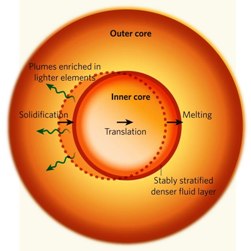 Lopsided melting in the eastern hemisphere of the Earth’s inner core suggests the planet’s heart is a much more dynamic place than previously thought. Harriet Jarlett reports.
Lopsided melting in the eastern hemisphere of the Earth’s inner core suggests the planet’s heart is a much more dynamic place than previously thought. Harriet Jarlett reports.
Geoscientist Online 26 August 2010
Only about 10 million years after the Earth accreted, in an event known as the “iron catastrophe” dense liquid metals (mainly nickel, iron and dissolved “iron-loving” elements) separated out from silicate phases and settled at the centre of the Earth. As the planet cooled, perhaps about a billion years ago, this liquid core began to develop a solid inner core that has been steadily growing ever since.
But far from being an inert mass like some sort of planetary kidney-stone, scientists now believe it is a dynamic object, continuously solidifying on one side and melting on the other. They have now come up with a new unified model that can, they think, explain some of the inner (and outer) cores’ more bizarre seismic properties.
Seismologists have long known that seismic waves travel faster through the inner core in a north-south direction than west-east (the east-west direction also possess a range of different seismic asymmetries). The cause of this complex anisotropy is not known - but is thought to involve the alignment of iron crystals.
Odder still, at the base of the liquid outer core, seismologists have observed a c. 200km-thick layer of denser fluid apparently hugging the inner core. This is odd, because since the core was supposed to be slowly solidifying from the centre out, the liquid outer core should be becoming enriched in all the lighter alloying elements - just as the freezing of salt water creates pure water ice and an increased salinity brine.
What is more, the less dense fluid should be most abundant at the surface of the outer core where crystallisation is taking place – and yet that is precisely where more dense material seems to reside. Also, we know that the outer core convects and, in a geodynamo effect, creates the Earth’s magnetic field. How does the mysterious basal dense layer remain un-entrained?
Thierry Alboussiere (Laboratoire de Géophysique Interne et Tectonophysique, CNRS, Observatoire de Grenoble) and colleagues from the University of Lyons and Johns Hopkins University
1 now think they have the answer, and that their model can explain both anomalous facts.
They argue that the material in the inner core is moving slowly eastwards all the time, from precipitation in the west to re-melting in the east. As it solidifies it releases plumes enriched in lighter elements. As it melts again in the east 100 million years later – the time they think it takes for crystals to move from one side to another – it results in an iron-rich fluid layer that is denser than the rest of the outer core. This dense layer clings to the inner core as the process proceeds, but is not disrupted in the east by the release of less-dense fluids where crystallisation occurs. Experimental evidence seems to suggest that the less dense material passes through the overlying dense shell in small plumes – like jest of water through a watering-can rose. The jets then go on to drive the compositional convection that characterises the geodynamo above the layer.
Based on an inner core 2400km in diameter that is approximately a billion years old, its overall growth rate would be 10
-11 m s
-1. By contrast the translational velocity – movement of material from one side of the core to another - is probably orders of magnitude greater than this. Alboussiere
et al. believe that the inner core renews itself every 100 million years.
Since movement in the inner core affects the outer core geodynamo, the proposed lopsided melting may now force scientists to rethink how the Earth's magnetism works.
References:
- Alboussiere, T., Deguen, R., Melzani, M. Melting-induced stratification above the Earth/'s inner core due to convective translation. Nature 466, 744-747, doi:10.1038/nature09257.
- Bergman, M. I. Earth science: An inner core slip-sliding away. Nature 466, 697-698 (2010).